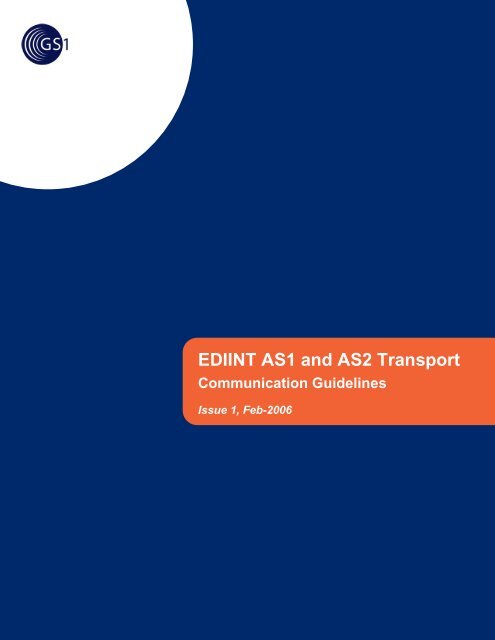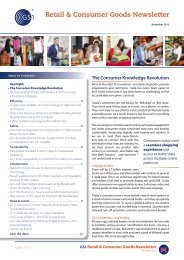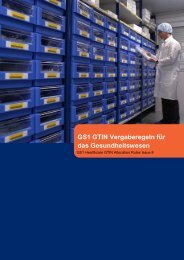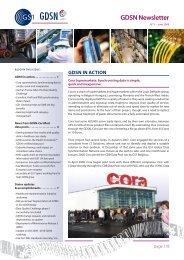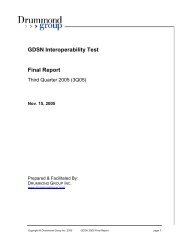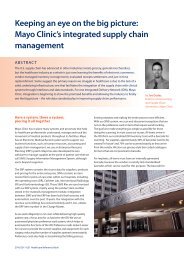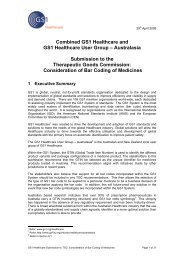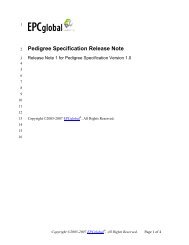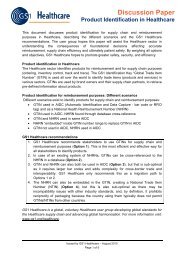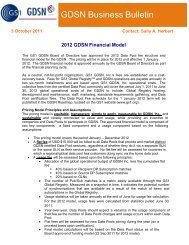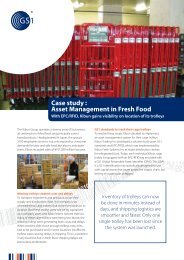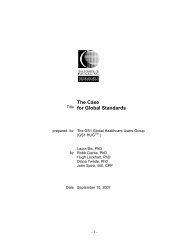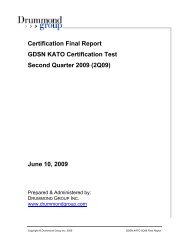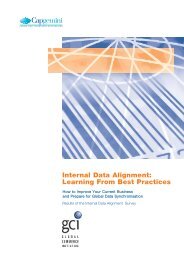EDIINT AS1 and AS2 Transport Communication Guidelines - GS1
EDIINT AS1 and AS2 Transport Communication Guidelines - GS1
EDIINT AS1 and AS2 Transport Communication Guidelines - GS1
You also want an ePaper? Increase the reach of your titles
YUMPU automatically turns print PDFs into web optimized ePapers that Google loves.
<strong>EDIINT</strong> <strong>AS1</strong> <strong>and</strong> <strong>AS2</strong> <strong>Transport</strong> <strong>Communication</strong> <strong>Guidelines</strong><br />
<strong>EDIINT</strong> <strong>AS1</strong> <strong>and</strong> <strong>AS2</strong> <strong>Transport</strong><br />
<strong>Communication</strong> <strong>Guidelines</strong><br />
Issue 1, Feb-2006<br />
Feb-2006, Issue 1 All contents copyright © <strong>GS1</strong> 2006 Page 1 of 24
<strong>EDIINT</strong> <strong>AS1</strong> <strong>and</strong> <strong>AS2</strong> <strong>Transport</strong> <strong>Communication</strong> <strong>Guidelines</strong><br />
Document Summary<br />
Document Item<br />
Document Title<br />
Date Last Modified<br />
Current Value<br />
<strong>EDIINT</strong> <strong>AS1</strong> <strong>and</strong> <strong>AS2</strong> <strong>Transport</strong> <strong>Communication</strong> <strong>Guidelines</strong><br />
Feb-2006<br />
Current Document Issue Issue 1<br />
Status<br />
Document Description<br />
(one sentence summary)<br />
Approved<br />
This document defines the <strong>EDIINT</strong> <strong>AS1</strong> <strong>and</strong> <strong>AS2</strong> <strong>Transport</strong><br />
<strong>Communication</strong> <strong>Guidelines</strong> used by companies participating in e-<br />
Commerce using the <strong>GS1</strong> published XML, EANCOM, I/C, UCS, <strong>and</strong><br />
VICS data format st<strong>and</strong>ards.<br />
Contributors<br />
This document was developed by the Electronic Commerce Global Implementation Forum (ecGIF) group within<br />
<strong>GS1</strong>.<br />
Name<br />
John Duker<br />
(duker.jp@pg.com)<br />
Jin Chun<br />
(jchun@agentrics.com)<br />
Organization<br />
Procter & Gamble<br />
Agentrics<br />
Log of Changes in Issue 1<br />
Issue No. Date of Change Changed By Summary of Change<br />
1 Feb-2006 First Issue<br />
Disclaimer<br />
“Whilst every effort has been made to ensure that the guidelines to use the <strong>GS1</strong> st<strong>and</strong>ards contained in the<br />
document are correct, <strong>GS1</strong> <strong>and</strong> any other party involved in the creation of the document HEREBY STATE that<br />
the document is provided without warranty, either expressed or implied, of accuracy or fitness for purpose, AND<br />
HEREBY DISCLAIM any liability, direct or indirect, for damages or loss relating to the use of the document. The<br />
document may be modified, subject to developments in technology, changes to the st<strong>and</strong>ards, or new legal<br />
requirements.“<br />
Feb-2006, Issue 1 All contents copyright © <strong>GS1</strong> 2006 Page 2 of 24
<strong>EDIINT</strong> <strong>AS1</strong> <strong>and</strong> <strong>AS2</strong> <strong>Transport</strong> <strong>Communication</strong> <strong>Guidelines</strong><br />
Table of Contents<br />
1. Overview ............................................................................................................... 4<br />
2. Introduction .......................................................................................................... 4<br />
2.1. SCOPE OF CHANGES FOR THESE GUIDELINES ......................................................................... 4<br />
3. Objectives ............................................................................................................. 4<br />
4. <strong>Communication</strong> Concept..................................................................................... 5<br />
4.1. EDI Syntax ......................................................................................................................................... 5<br />
4.2. XML Syntax........................................................................................................................................ 5<br />
4.3. DATA Delivery.................................................................................................................................... 6<br />
5. Internet <strong>Transport</strong> Using <strong>EDIINT</strong>-<strong>AS1</strong> & <strong>EDIINT</strong>-<strong>AS2</strong>........................................ 6<br />
5.1. Introduction......................................................................................................................................... 6<br />
5.2. Specifications ..................................................................................................................................... 6<br />
5.3. Conformance Validation..................................................................................................................... 7<br />
5.4. Requirements..................................................................................................................................... 8<br />
5.4.1. Encryption <strong>and</strong> Signature Requirements ................................................................................. 8<br />
5.4.2. Configuration Requirement ...................................................................................................... 9<br />
5.5. Recommendations ............................................................................................................................. 9<br />
5.6. Synchronous vs. Asynchronous MDNs............................................................................................ 11<br />
5.6.1. Synchronous Mode MDN ....................................................................................................... 12<br />
5.6.2. Asynchronous Mode MDN ..................................................................................................... 12<br />
5.7. Network Availability .......................................................................................................................... 13<br />
5.8. Implementation Considerations........................................................................................................ 13<br />
5.8.1. <strong>EDIINT</strong>-<strong>AS1</strong> & <strong>EDIINT</strong>-<strong>AS2</strong> FUNCTIONALITY COMPARED................................................ 13<br />
5.8.2. INTERNET FACILITIES ......................................................................................................... 13<br />
5.8.3. Internal Facilities .................................................................................................................... 14<br />
5.8.4. Signed Receipts ..................................................................................................................... 14<br />
5.8.5. Certificates.............................................................................................................................. 14<br />
5.8.6. Support Services .................................................................................................................... 14<br />
5.8.7. Point to Point .......................................................................................................................... 15<br />
A. Glossary .............................................................................................................. 16<br />
B. FIGURES ............................................................................................................. 19<br />
Feb-2006, Issue 1 All contents copyright © <strong>GS1</strong> 2006 Page 3 of 24
<strong>EDIINT</strong> <strong>AS1</strong> <strong>and</strong> <strong>AS2</strong> <strong>Transport</strong> <strong>Communication</strong> <strong>Guidelines</strong><br />
1. Overview<br />
This document defines the <strong>EDIINT</strong> <strong>AS1</strong> <strong>and</strong> <strong>AS2</strong> <strong>Transport</strong> <strong>Communication</strong> <strong>Guidelines</strong> used by<br />
companies participating in e-Commerce using the <strong>GS1</strong> published XML, EANCOM, I/C, UCS, <strong>and</strong><br />
VICS data format st<strong>and</strong>ards. This document was developed by the Electronic Commerce Global<br />
Implementation Forum (ecGIF) group within <strong>GS1</strong>. Contact information for ecGIF co-chairs: John<br />
Duker, Procter & Gamble, duker.jp@pg.com; Jin Chun, Agentrics jchun@agentrics.com.<br />
All <strong>GS1</strong> documents are maintained by the <strong>GS1</strong> Global St<strong>and</strong>ards Management Process, which<br />
operates under the <strong>GS1</strong> auspices. All inquires concerning <strong>GS1</strong> should be directed to your local <strong>GS1</strong><br />
Member Organisation – see: http://www.gs1.org/contact/worldwide.php<br />
<strong>GS1</strong><br />
Avenue Louise 326 – Bte 10<br />
1050 Brussels – Belgium<br />
Tel: 32(0)2-788 78 00<br />
This document defines the technical communication protocols used to transport EDI <strong>and</strong> XML data<br />
from one computer to another computer. A major objective of the <strong>Communication</strong> <strong>Guidelines</strong> is<br />
general accessibility to all sizes <strong>and</strong> type of companies, with security at least as high as today’s<br />
conventional mail or telephone service. It is important to note, however, that each participant in these<br />
guidelines is responsible for taking whatever steps necessary to protect the confidentiality of its data.<br />
Further, the legality of transmitted electronic messages such as EDI <strong>and</strong> XML is left to the<br />
marketplace, <strong>and</strong> to the negotiation between individual buyers <strong>and</strong> sellers.<br />
2. Introduction<br />
The <strong>Communication</strong> <strong>Guidelines</strong> documented in the following pages have been designed to provide a<br />
practical <strong>and</strong> st<strong>and</strong>ard approach to the electronic exchange of data between participants. The<br />
objectives of the <strong>GS1</strong> Global St<strong>and</strong>ards Management Process in creating the document are to:<br />
• Provide for the communication of EDI <strong>and</strong> XML data<br />
• Identify alternative communication methods<br />
• Specify the communication guidelines for industry use<br />
• Provide operational guidelines for the use of the <strong>EDIINT</strong>-<strong>AS1</strong><strong>and</strong> <strong>EDIINT</strong>-<strong>AS2</strong> st<strong>and</strong>ards<br />
2.1. SCOPE OF CHANGES FOR THESE GUIDELINES<br />
A previous version of this document was published in the UCS <strong>Communication</strong>s St<strong>and</strong>ard as the “E-<br />
Commerce <strong>Transport</strong> <strong>Communication</strong> <strong>Guidelines</strong>” st<strong>and</strong>ard.<br />
3. Objectives<br />
One goal of the <strong>GS1</strong> Global St<strong>and</strong>ards Management Process is to provide communication<br />
methodologies to enable parties to exchange information between computers. The resulting<br />
<strong>Communication</strong> <strong>Guidelines</strong> specify the means of packaging EDI <strong>and</strong> XML data, <strong>and</strong> transferring it from<br />
a sender to a receiver.<br />
The following objectives are considered in developing the <strong>Communication</strong> <strong>Guidelines</strong>:<br />
• The use of proven technologies which are generally available.<br />
• Enable participation by both large <strong>and</strong> small business entities.<br />
Feb-2006, Issue 1 All contents copyright © <strong>GS1</strong> 2006 Page 4 of 24
<strong>EDIINT</strong> <strong>AS1</strong> <strong>and</strong> <strong>AS2</strong> <strong>Transport</strong> <strong>Communication</strong> <strong>Guidelines</strong><br />
• Provide for implementation at a reasonable cost.<br />
• Provide communication guidelines, which include recommended operational requirements<br />
such as network availability for incoming connections <strong>and</strong> encryption characteristics. These<br />
guidelines are defined in light of current operating environments.<br />
• Provide data integrity <strong>and</strong> security that is equal to or better than current methods of operation.<br />
4. <strong>Communication</strong> Concept<br />
Message st<strong>and</strong>ards allow users to convert business documents into a format that can be electronically<br />
exchanged. Such EDI or XML business documents are referred to as “transaction sets”, “messages”,<br />
or “documents”, <strong>and</strong> their format is defined in the XML, EANCOM, I/C, UCS, <strong>and</strong> VICS data format<br />
message st<strong>and</strong>ards. The exchange of these business documents is a component of overall e-<br />
Commerce. The <strong>Communication</strong> <strong>Guidelines</strong> provide for the exchange of EDI interchanges <strong>and</strong> XML<br />
documents, transporting them from one company to another. Throughout this document, interchanges<br />
<strong>and</strong> documents will be referred to as EDI <strong>and</strong> XML data or as text.<br />
As e-Commerce evolves <strong>and</strong> additional solutions become available, it is important for organisations to<br />
incorporate new services into their infrastructure, while continuing to support their existing trading<br />
partnerships. It is expected that multiple communication options will be used within organisations<br />
including Internet exchange, web services, direct connections, eMarketplaces (Exchanges), <strong>and</strong> Value<br />
Added Networks (VANs). These blended models will facilitate the growth of the global trading<br />
community to meet various business requirements.<br />
4.1. EDI Syntax<br />
EANCOM message st<strong>and</strong>ards refer to formatted business documents as “messages”. I/C, UCS <strong>and</strong><br />
VICS message st<strong>and</strong>ards refer to formatted business documents as “transaction sets”. Both<br />
messages <strong>and</strong> transaction sets are made up of variable length data segments. Messages [transaction<br />
sets] are bounded by a message header segment (UNH) [transaction set header segment (ST)] <strong>and</strong> a<br />
message trailer segment (UNT) [transaction set trailer segment (SE)].<br />
Groups of similar messages [transaction sets] are combined into functional groups. Functional groups<br />
can be [are] bounded by a functional group header segment (UNG) optional in EANCOM [(GS)] <strong>and</strong> a<br />
functional group trailer segment (UNE) optional in EANCOM [(GE)].<br />
Finally, functional groups are combined into interchanges. An interchange is bounded by an<br />
interchange control header segment (UNB) <strong>and</strong> optionally a service string advice segment (UNA)<br />
[(ISA)] <strong>and</strong> an interchange control trailer segment interchange trailer segment (UNZ) [(IEA)]. For<br />
specific details on this syntax, refer to the appropriate data format message st<strong>and</strong>ard.<br />
4.2. XML Syntax<br />
XML message st<strong>and</strong>ards refer to formatted business documents as “documents”. XML documents<br />
begin with the XML “declaration” in the first line of the document. This is followed by the “root<br />
element”. Elements contain XML “tags” <strong>and</strong> content. Elements may also have “attributes” which<br />
contain information about the element <strong>and</strong> are delimited by quotation marks.<br />
XML documents must be “well formed” <strong>and</strong> they may be “valid”. Well-formed documents must contain<br />
at least one element. They must have properly nested tags, <strong>and</strong> the root element must be unique.<br />
XML documents may also be checked for validity, but it is not required that they be valid. XML<br />
documents are valid if they conform to a template containing rules such as a schema or a DTD. A<br />
document that does not have a schema or a DTD is not valid. A document that has a schema or a<br />
DTD but does not conform to it is invalid. For specific details on this syntax, refer to the appropriate<br />
data format message st<strong>and</strong>ard.<br />
Feb-2006, Issue 1 All contents copyright © <strong>GS1</strong> 2006 Page 5 of 24
<strong>EDIINT</strong> <strong>AS1</strong> <strong>and</strong> <strong>AS2</strong> <strong>Transport</strong> <strong>Communication</strong> <strong>Guidelines</strong><br />
4.3. DATA Delivery<br />
Delivery of EDI <strong>and</strong> XML data using this guideline occurs between a pair of participants utilizing the<br />
public Internet. <strong>Communication</strong> is always in a single direction, with the party sending data initiating the<br />
communication. Data is deposited at the recipient’s location in what may be called an EDI or XML<br />
mailbox. After a connection is established, one or more EDI interchanges or XML documents may be<br />
sent. Both EDI interchange(s) <strong>and</strong> XML document(s) are sent as a continuous stream of data, with no<br />
physical record separator or line delimiter characters embedded in the data stream.<br />
A participant may utilize the facilities of a third party service bureau known as a Value Added Network<br />
(VAN), Exchange or e-Marketplace in lieu of a total in-house implementation. The third party becomes<br />
either the sending or receiving partner in the two-party communication. Transfer of EDI or XML data<br />
between a company <strong>and</strong> a third party acting as their agent can occur in any format mutually arranged<br />
between the company <strong>and</strong> the third party.<br />
5. Internet <strong>Transport</strong> Using <strong>EDIINT</strong>-<strong>AS1</strong> & <strong>EDIINT</strong>-<strong>AS2</strong><br />
These recommended implementation guidelines provide for the secure delivery of EDI or XML data<br />
using Internet transport. They define communications methods that may be used to transfer EDI or<br />
XML data between companies. Although they were developed primarily to support direct trading<br />
partner transmissions as illustrated in Figure 1 <strong>and</strong> Figure 2, they may also be used with VANs, e-<br />
Marketplaces or Exchanges. There is a third Internet transport approach based on FTP called <strong>EDIINT</strong>-<br />
AS3. AS3 is a draft st<strong>and</strong>ard which has not yet reached RFC status <strong>and</strong> does not yet have widespread<br />
adoption. The AS3 draft st<strong>and</strong>ard will not be discussed further in this document.<br />
5.1. Introduction<br />
The Internet Engineering Task Force (IETF) is the body that develops <strong>and</strong> maintains st<strong>and</strong>ards<br />
(Internet-St<strong>and</strong>ards) <strong>and</strong> draft st<strong>and</strong>ards (Internet-Drafts) for the Internet. Internet documents are<br />
often referred to by their Request for Comment (RFC) number. RFCs can be found at<br />
http://www.ietf.org/rfc.html. For example, RFC 2821 is the document number for the “Simple Mail<br />
Transfer Protocol (SMTP)” <strong>and</strong> RFC 2616 is the document number for the “Hypertext Transfer<br />
Protocol (HTTP)” both used for Internet transport.<br />
Internet-Drafts are working documents of the IETF <strong>and</strong> its working groups. They are valid for a<br />
maximum of six months <strong>and</strong> may be updated, replaced, or made obsolete by other documents at any<br />
time. Internet-Drafts are "works in progress". To obtain a copy of any of the <strong>EDIINT</strong> documents<br />
referenced in the following pages, the reader may access them at http://www.ietf.org/ID.html<br />
5.2. Specifications<br />
This document defines a minimum set of parameters <strong>and</strong> options to enable companies to use Internet<br />
transport securely for the exchange of EDI or XML data. <strong>EDIINT</strong>-<strong>AS1</strong> is based upon SMTP <strong>and</strong><br />
<strong>EDIINT</strong>-<strong>AS2</strong> is based on HTTP. Both st<strong>and</strong>ards support the full range of required security - digital<br />
signature, encryption, <strong>and</strong> digitally signed return receipts. Figures 3 through 12 illustrate the process<br />
used to sign, encrypt <strong>and</strong> decrypt the data.<br />
The nomenclature used in the normative sections of this document (sections 5.4 <strong>and</strong> 5.5) complies<br />
with ISO rules as specified in Annex H of the ISO/IEC Directives, Part 2, 2004, 5th edition [ISODir2]:<br />
(http://isotc.iso.org/livelink/livelink.exe/4230517/ISO_IEC_Directives__Part_2__Rules_for_the_structur<br />
e_<strong>and</strong>_drafting_of_International_St<strong>and</strong>ards__2004__5th_edition___pdf_format_.pdf?func=doc.Fetch&<br />
nodeid=4230517)<br />
The guidelines are based on work published by the EDI over the Internet Working Group (<strong>EDIINT</strong>) of<br />
the IETF, <strong>and</strong> the results of vendor conformance testing. The <strong>EDIINT</strong> Working Group developed RFC<br />
Feb-2006, Issue 1 All contents copyright © <strong>GS1</strong> 2006 Page 6 of 24
<strong>EDIINT</strong> <strong>AS1</strong> <strong>and</strong> <strong>AS2</strong> <strong>Transport</strong> <strong>Communication</strong> <strong>Guidelines</strong><br />
1767 titled “MIME Encapsulation of EDI Objects” which allows EDI <strong>and</strong> XML data to be sent as an<br />
Internet Message as a special application type. RFC 1767 is on a st<strong>and</strong>ards track within the IETF.<br />
The IETF has published four additional documents:<br />
1. <strong>AS1</strong> - “MIME-based Secure Peer-to-Peer Business Data Interchange Over the Internet”<br />
(http://www.ietf.org/rfc/rfc3335.txt )<br />
2. <strong>AS2</strong> - “MIME-based Secure Peer-to-Peer Business Data Interchange Using HTTP, Applicability<br />
Statement 2 (<strong>AS2</strong>)”.<br />
(http://www.ietf.org/rfc/rfc4130.txt )<br />
3. “Compressed Data for <strong>EDIINT</strong>”<br />
(http://www.ietf.org/internet-drafts/draft-ietf-ediint-compression-05.txt<br />
4. “Certificate Exchange Message (CEM) for <strong>EDIINT</strong>”<br />
(https://datatracker.ietf.org/public/idindex.cgi?comm<strong>and</strong>=id_detail&id=12703)<br />
These documents <strong>and</strong> successor documents (published with incremented version numbers) are the<br />
basis for these <strong>Guidelines</strong>. We shall refer to the current specification documents in the following pages<br />
as “<strong>AS1</strong>” <strong>and</strong> “<strong>AS2</strong>”.<br />
Currently, the Internet-St<strong>and</strong>ards <strong>and</strong> Internet-Drafts referenced in <strong>AS1</strong> <strong>and</strong> <strong>AS2</strong> to achieve the<br />
minimum requirements of the <strong>AS1</strong> <strong>and</strong> <strong>AS2</strong> St<strong>and</strong>ards are as follows:<br />
• RFC 1123 Requirements for Internet Hosts<br />
• RFC 1767 MIME Encapsulation of EDI Objects<br />
• RFC 1847 Security Multiparts for MIME<br />
• RFC 2045 MIME Format of Internet Message Bodies<br />
• RFC 2046 MIME Media Types<br />
• RFC 2049 MIME Conformance Criteria <strong>and</strong> Examples<br />
• RFC 2298 An Extensible Message Format for Message Disposition Notifications<br />
• RFC 2616 Hypertext Transfer Protocol -- HTTP/1.1<br />
• RFC 2821 Simple Mail Transfer Protocol (SMTP)<br />
• RFC 2822 St<strong>and</strong>ard for the Format of Internet Text Messages<br />
• RFC 3370 Cryptographic Message Syntax (CMS) Algorithms<br />
• RFC 3798 Message Disposition Notification<br />
• RFC 3851 S/MIME Version 3.1 Message Specification<br />
• RFC 3852 Cryptographic Message Syntax<br />
5.3. Conformance Validation<br />
To ensure that different software vendors’ products meet the <strong>AS1</strong> <strong>and</strong> <strong>AS2</strong> st<strong>and</strong>ards, <strong>and</strong> that the<br />
products interoperate successfully with each other, <strong>GS1</strong> has sponsored several vendor conformance<br />
validation tests. The Drummond Group Inc., an interoperability conformance consultancy, conducts the<br />
conformance testing. The results of these tests are documented as follows:<br />
For <strong>AS1</strong>: http://www.drummondgroup.com/html-v2/as1-companies.html<br />
For <strong>AS2</strong>: http://www.drummondgroup.com/html-v2/as2-companies.html<br />
Feb-2006, Issue 1 All contents copyright © <strong>GS1</strong> 2006 Page 7 of 24
<strong>EDIINT</strong> <strong>AS1</strong> <strong>and</strong> <strong>AS2</strong> <strong>Transport</strong> <strong>Communication</strong> <strong>Guidelines</strong><br />
5.4. Requirements<br />
The following are minimum <strong>GS1</strong> requirements for secure Internet transport. Business conditions may<br />
dictate higher levels of security for certain business documents or processes. Subsequent sections will<br />
list recommended practices. Requirements <strong>and</strong> recommendations apply equally to <strong>AS1</strong> <strong>and</strong> <strong>AS2</strong><br />
unless otherwise noted.<br />
Organisations that adopt these <strong>Guidelines</strong> may decide to use functionality beyond the minimum<br />
requirements as long as:<br />
• The functionality is defined in <strong>AS1</strong> <strong>and</strong>/or <strong>AS2</strong><br />
-And-<br />
• Both parties mutually agree to use the extended functionality<br />
5.4.1. Encryption <strong>and</strong> Signature Requirements<br />
Requirement 1:<br />
Payload data SHALL be encrypted <strong>and</strong> digitally signed using the S/MIME specification (see RFC<br />
3851).<br />
Requirement 2:<br />
The length of the one-time session (symmetric) key SHALL be 128 bits or greater.<br />
Note: Key lengths less than 128 bits are no longer considered secure. Triple DES, which uses<br />
3 separate 56 bit keys to encrypt the data three times, is the recommended encryption<br />
algorithm. A newer algorithm called Advanced Encryption St<strong>and</strong>ard (AES), while not currently<br />
used for <strong>EDIINT</strong> encryption, was developed under the National Institute of St<strong>and</strong>ards <strong>and</strong><br />
Technology leadership <strong>and</strong> supports key sizes of 128, 192, <strong>and</strong> 256 bits. AES is used by the US<br />
government <strong>and</strong> it is expected that it will be widely used by business applications in the future.<br />
There may be export or import restrictions affecting use of encryption technologies in a few<br />
countries. See http://www.bis.doc.gov/Encryption/Default.htm<br />
Requirement 3:<br />
The length of the Public/Private Encryption key SHALL be 1024 bits or greater.<br />
Note: Key length options for public/private keys are: 512, 1024, or 2048 bits.<br />
Requirement 4:<br />
The length of the Public/Private Signature key SHALL be 1024 bits or greater.<br />
Requirement 5:<br />
The Signature Hash algorithm used SHALL be SHA1.<br />
Note: SHA1 is considered a significantly stronger algorithm for creating document digests used<br />
for digital signatures than the MD5 algorithm.<br />
Feb-2006, Issue 1 All contents copyright © <strong>GS1</strong> 2006 Page 8 of 24
<strong>EDIINT</strong> <strong>AS1</strong> <strong>and</strong> <strong>AS2</strong> <strong>Transport</strong> <strong>Communication</strong> <strong>Guidelines</strong><br />
5.4.2. Configuration Requirement<br />
Requirement 6<br />
Digitally signed receipts (Signed Message Disposition Notifications [MDNs]) SHALL be requested by<br />
the Sender of Message (see Glossary).<br />
Note: MDNs provide a guarantee to the sender that the message has been received <strong>and</strong> the<br />
recipient has signed an acknowledgment<br />
5.5. Recommendations<br />
Recommendation 1 – MDN Request Option<br />
Either Asynchronous or Synchronous MDNs MAY be used with <strong>EDIINT</strong> <strong>AS2</strong>. There are potential<br />
issues with both synchronous <strong>and</strong> asynchronous MDNs, <strong>and</strong> Trading Partners need to jointly<br />
determine which option is best based on their operational environments <strong>and</strong> message characteristics.<br />
A discussion of both options follows these recommendations.<br />
Note: For <strong>EDIINT</strong> <strong>AS1</strong>, MDNs are always asynchronous, since SMTP (email) does not support<br />
bi-directional transmission.<br />
Recommendation 2 – MDN Delivery<br />
Recipients SHOULD transmit the MDN as soon as technically possible to ensure that the message<br />
sender recognizes that the message has been received <strong>and</strong> processed by the receiving <strong>EDIINT</strong><br />
software in a timely fashion. This applies equally to <strong>AS1</strong> <strong>and</strong> <strong>AS2</strong> as well as Asynchronous <strong>and</strong><br />
Synchronous MDN requests.<br />
Recommendation 3 – Delivery Resend with Asynchronous MDNs Requested<br />
When a message has been successfully sent, but an asynchronous MDN has not been received in a<br />
timely manner, the Sender of Message SHOULD wait a configurable amount of time <strong>and</strong> then<br />
automatically resend the original message. A delivery resend of a message SHALL have the same<br />
content <strong>and</strong> the same Message-ID value as the initial message. The period of time to wait for a MDN<br />
<strong>and</strong> then automatically resend the original message is based on business <strong>and</strong> technical needs, but<br />
generally SHOULD not be less than one hour. There SHOULD be no more than two automatic<br />
resends of a message before personally contacting a technical support contact at the Receiver of<br />
Message site. This applies equally to <strong>AS1</strong> <strong>and</strong> <strong>AS2</strong>.<br />
Recommendation 4 – Delivery Retry for <strong>AS2</strong><br />
Delivery retry SHOULD take place when any HTTP response other than “200 OK” is received (for<br />
example, 401, 500, 502, 503, timeout, etc). This occurrence indicates that the actual transfer of data<br />
was not successful. A delivery retry of a message SHALL have the same content <strong>and</strong> the same<br />
Message-ID value as the initial message. Retries SHOULD occur on a configurable schedule. Retrying<br />
SHALL cease when a message is successfully sent (which is indicated by receiving a HTTP 200 range<br />
status code), or SHOULD cease when a retry limit is exceeded.<br />
Recommendation 5 – Message Resubmission<br />
If neither automated Delivery Retry nor automated Delivery Resend are successful, the Sender of<br />
Message MAY elect to resubmit the payload data in a new message at a later time. The Receiver of<br />
Message MAY also request message resubmission if a message was lost subsequent to a successful<br />
receive. If the message is resubmitted a new Message-ID MUST be used. Resubmission is normally a<br />
manual compensation.<br />
Feb-2006, Issue 1 All contents copyright © <strong>GS1</strong> 2006 Page 9 of 24
<strong>EDIINT</strong> <strong>AS1</strong> <strong>and</strong> <strong>AS2</strong> <strong>Transport</strong> <strong>Communication</strong> <strong>Guidelines</strong><br />
Recommendation 6 – HTTP vs. HTTP/S (SSL)<br />
For <strong>EDIINT</strong> <strong>AS2</strong>, the transport protocol HTTP SHOULD be used. However, if there is a need to<br />
secure the <strong>AS2</strong>-To <strong>and</strong> the <strong>AS2</strong>-From addresses <strong>and</strong> other <strong>AS2</strong> header information, HTTPS MAY be<br />
used in addition to the payload encryption provided by <strong>AS2</strong>. The encryption provided by HTTPS<br />
secures only the point to point communications channel directly between the client <strong>and</strong> the server.<br />
Note: HTTPS might introduce operational complexities.<br />
Recommendation 7 – <strong>AS2</strong> Header<br />
For <strong>EDIINT</strong> <strong>AS2</strong>, the values used in the <strong>AS2</strong>-From <strong>and</strong> <strong>AS2</strong>-To fields in the header SHOULD be <strong>GS1</strong><br />
Global Location Numbers (GLNs).<br />
Note: The GLNs SHOULD be that of the sending server <strong>and</strong> receiving server respectively.<br />
When a hub or VAN is used, the GLN of the trading partner MAY be used when the <strong>AS2</strong> To<br />
field is used for routing. Existing <strong>AS2</strong> installations using values other than GLNs would need to<br />
reconfigure their software <strong>and</strong> coordinate with all of their trading partners prior to converting to<br />
the use of GLNs.<br />
Recommendation 8 - SMTP<br />
For <strong>EDIINT</strong> <strong>AS1</strong>, a dedicated SMTP server, separate from the normal email server SHOULD be used<br />
to ensure operational reliability.<br />
Recommendation 9 - Compression<br />
<strong>EDIINT</strong> compression MAY be used as an option, especially if message sizes are larger than 1MB.<br />
Although current versions of <strong>EDIINT</strong> software h<strong>and</strong>le compression automatically, this SHOULD be<br />
bilaterally agreed between the sender <strong>and</strong> the receiver.<br />
Note: If used, compression SHOULD comply with the IETF document “Compressed Data for<br />
<strong>EDIINT</strong>” http://www.ietf.org/internet-drafts/draft-ietf-ediint-compression-05.txt<br />
Recommendation 10 – Digital Certificate Characteristics<br />
Digital certificates MAY either be from a trusted third party or self signed if bilaterally agreed between<br />
trading partners. If certificates from a third party are used, the trust level SHOULD be at a minimum<br />
what is termed ‘Class 2’ which ensures that validation of the individual <strong>and</strong> the organisation has been<br />
done.<br />
Recommendation 11 – Common Digital Certificate for Encryption & Signature<br />
A single digital certificate MAY be used for both encryption <strong>and</strong> signatures, however if business<br />
processes dictate, two separate certificates MAY be used. Although current versions of <strong>EDIINT</strong><br />
software h<strong>and</strong>le two certificates automatically, this SHOULD be bilaterally agreed between the sender<br />
<strong>and</strong> the receiver.<br />
Recommendation 12 – Digital Certificate Validity Period<br />
The minimum validity period for a certificate SHOULD be 1 year. The maximum validity period<br />
SHOULD be 5 years.<br />
Recommendation 13 – Digital Certificate – Automated Exchange<br />
The method for certificate exchange SHALL be bilaterally agreed upon. When the Certificate<br />
Exchange Messaging for <strong>EDIINT</strong> specification is widely implemented by software vendors, its use will<br />
be strongly recommended. This IETF specification will enable automated certificate exchange once<br />
Feb-2006, Issue 1 All contents copyright © <strong>GS1</strong> 2006 Page 10 of 24
<strong>EDIINT</strong> <strong>AS1</strong> <strong>and</strong> <strong>AS2</strong> <strong>Transport</strong> <strong>Communication</strong> <strong>Guidelines</strong><br />
the initial trust relationship is established, <strong>and</strong> will significantly reduce the operational burden of<br />
manually exchanging certificates prior to their expiration.<br />
Note: See IETF document:<br />
https://datatracker.ietf.org/public/idindex.cgi?comm<strong>and</strong>=id_detail&id=12703<br />
Recommendation 14 – HTTP <strong>and</strong> HTTP/S Port Numbers for <strong>AS2</strong><br />
Receiving <strong>AS2</strong> messages on a single port (for each protocol) significantly minimizes operational<br />
complexities such as firewall set-up <strong>and</strong> potential security exposures for both the sending <strong>and</strong><br />
receiving partner. Ideally, all <strong>AS2</strong> partners would receive messages using the same port number.<br />
However some <strong>AS2</strong> partners have previously st<strong>and</strong>ardized to use a different port number than others<br />
<strong>and</strong> changing to a new port number would add costs without commensurate benefits.<br />
Therefore <strong>AS2</strong> partners MAY st<strong>and</strong>ardize on the use of port 4080 to receive HTTP messages <strong>and</strong> the<br />
use of port 5443 to receive HTTP/S (SSL) messages.<br />
Recommendation 15 – Duplicate <strong>AS2</strong> Messages<br />
<strong>AS2</strong> software implementations SHOULD use the ‘<strong>AS2</strong> Message-ID’ value to detect duplicate<br />
messages <strong>and</strong> avoid sending the payload from the duplicate message to internal business<br />
applications. The Receiver of Message SHALL return an appropriate MDN even when a message is<br />
detected as a duplicate.<br />
Note: The Internet Engineering Task Force (IETF) is developing an Operational Reliability for<br />
<strong>EDIINT</strong> <strong>AS2</strong> specification which defines procedures to avoid duplicates <strong>and</strong> ensure reliability.<br />
Note: See IETF document:<br />
https://datatracker.ietf.org/public/idindex.cgi?comm<strong>and</strong>=id_detail&id=13578<br />
Recommendation 16 – Technical Support<br />
There SHOULD be a technical support contact for each Sender of Message <strong>and</strong> Receiver of Message.<br />
The contact information SHOULD include name, email address <strong>and</strong> phone number. For 24x7x365<br />
operation, a pager or help desk information SHOULD be also provided.<br />
5.6. Synchronous vs. Asynchronous MDNs<br />
When requesting Message Disposition Notifications (MDNs), two different modes of <strong>AS2</strong> behaviour<br />
are available. In asynchronous mode, the MDN is sent over a different TCP connection than was used<br />
by the initial message. In synchronous mode, the MDN is sent using the HTTP(s) response over the<br />
existing TCP connection used by the initial message.<br />
In principle, <strong>AS2</strong> applications support either mode of operation, <strong>and</strong> it is a matter of agreement within<br />
the business relationship which mode of operation will be used. However, because usage<br />
characteristics <strong>and</strong> resource capacities can impact the modes of operation differently, the agreement<br />
should take into account a number of factors.<br />
A chart of “Pros” <strong>and</strong> “Cons” pertaining to MDN mode for <strong>AS2</strong> messages follows. This chart assumes<br />
that both partners (at different times) are initiating messages to be sent <strong>and</strong> will therefore also have<br />
infrastructure to receive messages.<br />
Feb-2006, Issue 1 All contents copyright © <strong>GS1</strong> 2006 Page 11 of 24
<strong>EDIINT</strong> <strong>AS1</strong> <strong>and</strong> <strong>AS2</strong> <strong>Transport</strong> <strong>Communication</strong> <strong>Guidelines</strong><br />
5.6.1. Synchronous Mode MDN<br />
Pro<br />
• Fewer TCP connections are made in fewer directions.<br />
• One partner can send data without having to listen on any port.<br />
• Easier to track state of the protocol in that state does not have to be preserved between TCP<br />
connections. However, the protocol state must be persisted during application failure.<br />
Con<br />
• For large messages or heavily loaded servers, resources on both sides are tied up holding the<br />
connection open until the MDN is sent. Since significant processing may be needed to decrypt<br />
a message prior to the creation of a MDN, synchronous MDNs can result in transmission<br />
failures due to HTTP timeouts. High resource utilization levels tend to favour higher exception<br />
levels <strong>and</strong> overall higher system error rates.<br />
• When the MDN response takes a long time to produce, an inactivity timer may close down the<br />
connection. [This timer may be in a network device or in the <strong>AS2</strong> application.] Retries may just<br />
put the server under additional load, <strong>and</strong> not improve the delivery result.<br />
• If the receiving <strong>AS2</strong> application fails while waiting to send an MDN, <strong>and</strong> that protocol state is<br />
not persisted, the Sender of Message will not receive the MDN <strong>and</strong> may need to initiate a<br />
resend of the message.<br />
• The use of proxy servers may preclude using synchronous MDNs.<br />
5.6.2. Asynchronous Mode MDN<br />
Pro<br />
• Receiving the message is decoupled from processing the message <strong>and</strong> returning the MDN. As<br />
a result, HTTP sessions are freed as soon as the message is delivered (indicated by HTTP<br />
“200 OK” response code). This can alleviate connection time-out issues, especially for large<br />
messages or heavily loaded servers<br />
• Potentially fewer concurrent TCP sessions due to shorter latency period, thus reducing<br />
memory <strong>and</strong> other requirements<br />
• Message processing tasks (decryption <strong>and</strong> signature validation) <strong>and</strong> MDN generation can be<br />
undertaken after peak loads level off. [Asynchronous mode has a “checkpoint” between<br />
delivery <strong>and</strong> MDN creation.]<br />
Con<br />
• The state of the expected MDN must be tracked so that the arriving MDN is correlated<br />
correctly with previously sent <strong>AS2</strong> message.<br />
• More resources are required to create separate HTTP connections to return MDNs. For SSL,<br />
more SSL setup work will be required.<br />
• Asynchronous mode may lead to duplicate messages being resent if MDN fails to arrive<br />
“quickly enough” <strong>and</strong> if application has resending logic active.<br />
Feb-2006, Issue 1 All contents copyright © <strong>GS1</strong> 2006 Page 12 of 24
<strong>EDIINT</strong> <strong>AS1</strong> <strong>and</strong> <strong>AS2</strong> <strong>Transport</strong> <strong>Communication</strong> <strong>Guidelines</strong><br />
5.7. Network Availability<br />
Except for scheduled maintenance, it is recommended that companies be capable of receiving EDI or<br />
XML data from their trading partners twenty-four hours a day, seven days a week. It is recognized that<br />
maintenance time can result in system outages, so maintenance time should be scheduled in<br />
advance, on a consistent basis, <strong>and</strong> communicated to trading partners. Notification to trading partners<br />
of planned outages should reduce the occurrence of alerts <strong>and</strong> errors when attempting to send to a<br />
system that is down.<br />
5.8. Implementation Considerations<br />
5.8.1. <strong>EDIINT</strong>-<strong>AS1</strong> & <strong>EDIINT</strong>-<strong>AS2</strong> FUNCTIONALITY COMPARED<br />
Supported Functionality<br />
<strong>EDIINT</strong>-<strong>AS1</strong><br />
[SMTP]<br />
<strong>EDIINT</strong>-<strong>AS2</strong><br />
[HTTP(S)]<br />
Privacy X X<br />
Authentication X X<br />
Integrity X X<br />
Non-repudiation of Receipt X X<br />
EDI Data Format X X<br />
XML Data Format X* X<br />
Transmit Large files without fragmenting (some SMTP servers<br />
automatically fragment large files into multiple partial messages)<br />
Synchronous Transmission (no intermediate servers nor<br />
potential delays)<br />
X<br />
X<br />
No special firewall rules needed<br />
Dial-up Internet connection<br />
X<br />
X**<br />
Notes:<br />
* While XML is not technically a part of the <strong>AS1</strong> specification <strong>and</strong> has not yet been tested for<br />
interoperability, most <strong>AS1</strong> software products support transporting the XML data format.<br />
** It is expected that the receiving partner will create <strong>and</strong> send an MDN receipt immediately upon<br />
completion of processing of the inbound data by the <strong>EDIINT</strong> Server.<br />
5.8.2. INTERNET FACILITIES<br />
Companies are advised to ensure that their Internet Service Provider, as well as their internal<br />
infrastructure, strictly conform to all Internet-St<strong>and</strong>ards <strong>and</strong> Internet-Drafts incorporated by reference<br />
into the <strong>AS1</strong> <strong>and</strong> <strong>AS2</strong> St<strong>and</strong>ards.<br />
In order to keep non-compliance issues to a minimum, it is recommended that companies<br />
implementing this Guideline initially test with companies already exchanging EDI or XML data using<br />
<strong>EDIINT</strong> transport as defined in these <strong>Guidelines</strong>.<br />
Companies should evaluate their Internet Service Provider (ISP) in terms of availability, reliability, <strong>and</strong><br />
responsiveness. Companies need to review or determine:<br />
Feb-2006, Issue 1 All contents copyright © <strong>GS1</strong> 2006 Page 13 of 24
<strong>EDIINT</strong> <strong>AS1</strong> <strong>and</strong> <strong>AS2</strong> <strong>Transport</strong> <strong>Communication</strong> <strong>Guidelines</strong><br />
• The type of network redundancy the ISP maintains<br />
• The physical connection of the ISP to the Internet Backbone<br />
• If the ISP owns their own infrastructure<br />
• The Service Level Agreements of the ISP<br />
• Any size or volume restrictions imposed by the ISP<br />
5.8.3. Internal Facilities<br />
When implementing these <strong>Guidelines</strong>, companies may also need to consider:<br />
• What is the physical connection between the company <strong>and</strong> the ISP<br />
• Is there single point of failure anywhere <strong>and</strong> will this impact "mission-critical" data<br />
• Internal restrictions or non-st<strong>and</strong>ard behaviour with Firewall, SMTP server, Network Address<br />
Translation (NAT), Gateway, Tunnel, or Proxy server components<br />
• Trading partners’ restrictions or non-st<strong>and</strong>ard behaviour with Firewall, NAT, Gateway, Tunnel,<br />
or Proxy server components<br />
• Production status of both SMTP Server (for <strong>AS1</strong>) <strong>and</strong> separate HTTP Server, if used, (for<br />
<strong>AS2</strong>). Support must be available 24x7x365 to ensure that e-Commerce transactions are not<br />
delayed.<br />
5.8.4. Signed Receipts<br />
For both EDI <strong>and</strong> XML data, signed Message Disposition Notification (MDN) receipts at the<br />
communications level are required. The MDNs are created by the <strong>EDIINT</strong> Server. MDNs are different<br />
from, <strong>and</strong> do not replace, EDI Functional Acknowledgments (CONTRL messages <strong>and</strong> 997 transaction<br />
sets) which are created at the translator level. It is expected that the receiving partner will create <strong>and</strong><br />
send an MDN receipt immediately upon completion of processing of the inbound data by the <strong>EDIINT</strong><br />
Server.<br />
5.8.5. Certificates<br />
The specifications on which these <strong>Guidelines</strong> are based define a st<strong>and</strong>ard-based method to<br />
automatically exchange <strong>and</strong> synchronize certificates (public/private keys) – see Recommendation 13.<br />
However, until this st<strong>and</strong>ards-based method to exchange certificates is widely implemented by<br />
software vendors, Companies may need to manually exchange certificates (either self-signed or from<br />
a trusted Certificate Authority) with each of their trading partners.<br />
In order to minimize the frequency with which certificates must be changed, companies may need to<br />
consider using the longest encryption key length that their partners can process beyond the minimum<br />
required by these <strong>Guidelines</strong>. Public/Private encryption <strong>and</strong> Signature key lengths can range from 512<br />
to 2048 bits. One-time Symmetric encryption key lengths can range from 40 to 256 bits. (See<br />
Requirements 2-4.) Key length is directly related to the time that it takes to break a key <strong>and</strong><br />
successfully decrypt a message. Other important factors for companies to consider are the monetary<br />
value of the EDI or XML transactions themselves, <strong>and</strong> their life span within the context of the industry.<br />
5.8.6. Support Services<br />
Each company that implements these <strong>Guidelines</strong> must provide its own support services. These<br />
include setting up <strong>and</strong> testing with new partners, logging <strong>and</strong> reporting on communications activity,<br />
<strong>and</strong> the diagnosis, tracing, <strong>and</strong> resolution of end to end communications problems. Value-added<br />
networks may currently provide these support services.<br />
Feb-2006, Issue 1 All contents copyright © <strong>GS1</strong> 2006 Page 14 of 24
<strong>EDIINT</strong> <strong>AS1</strong> <strong>and</strong> <strong>AS2</strong> <strong>Transport</strong> <strong>Communication</strong> <strong>Guidelines</strong><br />
The use of Internet transport for EDI or XML may complement existing Internet infrastructures. Each<br />
company must analyze the costs <strong>and</strong> benefits of this technology.<br />
5.8.7. Point to Point<br />
These <strong>Guidelines</strong> use encryption facilities within the communications protocol for security. As a result,<br />
these <strong>Guidelines</strong> were developed under the assumption that EDI or XML data moves from point to<br />
point in such a manner that no intermediate party needs access to the contents of the EDI or XML<br />
data itself. If an intermediate party needs to view the data for rerouting to an ultimate recipient, or<br />
perform value added processing, that intermediate party will need to decrypt <strong>and</strong> potentially re-encrypt<br />
the data.<br />
Feb-2006, Issue 1 All contents copyright © <strong>GS1</strong> 2006 Page 15 of 24
<strong>EDIINT</strong> <strong>AS1</strong> <strong>and</strong> <strong>AS2</strong> <strong>Transport</strong> <strong>Communication</strong> <strong>Guidelines</strong><br />
A. Glossary<br />
Term<br />
<strong>AS1</strong><br />
<strong>AS2</strong><br />
Authentication<br />
Ciphertext<br />
Digital Certificate<br />
Digital Signature<br />
Document Digest<br />
DTD<br />
EANCOM<br />
EDI<br />
<strong>EDIINT</strong><br />
Encryption<br />
<strong>GS1</strong><br />
<strong>GS1</strong> US<br />
HTTP<br />
I/C<br />
Definition<br />
Applicability Statement 1 – An Internet Request For Comment (RFC) defining<br />
how applications can securely transport EDI <strong>and</strong> XML over the Internet using<br />
SMTP. It specifies how to transport data files.<br />
Applicability Statement 2 – An Internet RFC defining how applications can<br />
securely transport EDI <strong>and</strong> XML over the Internet using HTTP. It specifies how<br />
to transport data files.<br />
Ensures the accurate identification of both the sender <strong>and</strong> the receiver. Is<br />
accomplished via digital signatures.<br />
Data that has been transformed from a ‘plaintext’ form into encrypted text (an<br />
unreadable form) via an encryption process.<br />
A document that contains name, serial number, expiration dates & a copy of<br />
the owner’s public key; used to encrypt data & validate signatures.<br />
An electronic signature that can be used to authenticate the identity of the<br />
sender of a message, <strong>and</strong> via the encrypted document digest, to ensure that<br />
the original content of the data that has been sent is unchanged.<br />
A unique "fingerprint" summary (128 or 160 bits long) of an input file. It is used<br />
to create a digital signature <strong>and</strong> to ensure that the file has not been altered. It is<br />
also called a ‘hash’ <strong>and</strong> is produced by a checksum program that processes a<br />
file.<br />
Data Type Definition – For an XML document, the DTD consists of mark-up<br />
code that indicates the grammar rules for the particular class of document. It<br />
specifies the valid syntax, structure, <strong>and</strong> format for defining the XML mark-up<br />
elements. <strong>GS1</strong> recommends the use of schemas versus DTDs.<br />
The EDI st<strong>and</strong>ard made available by <strong>GS1</strong>, which is an implementation<br />
guideline of the EDIFACT st<strong>and</strong>ard developed under the auspices of the United<br />
Nations.<br />
Electronic Data Interchange – The exchange of structured business data<br />
computer to computer. EDI data format st<strong>and</strong>ards are developed by the<br />
EDIFACT Working Group of the United Nations <strong>and</strong> the Accredited St<strong>and</strong>ards<br />
Committee (ASC) X12 of the American National St<strong>and</strong>ards Institute.<br />
EDI Over the Internet Working Group – A working group of the IETF that<br />
developed the <strong>AS1</strong> <strong>and</strong> <strong>AS2</strong> st<strong>and</strong>ards.<br />
A process that uses a mathematical algorithm <strong>and</strong> a key to transform data into<br />
an unreadable format (called ciphertext). A receiver can then use a key to<br />
restore the data to its original content.<br />
<strong>GS1</strong> is a leading global organisation dedicated to the design <strong>and</strong><br />
implementation of global st<strong>and</strong>ards <strong>and</strong> solutions to improve the efficiency <strong>and</strong><br />
visibility of supply <strong>and</strong> dem<strong>and</strong> chains globally <strong>and</strong> across sectors.<br />
The <strong>GS1</strong> Member Organisation for the United States.<br />
Hypertext <strong>Transport</strong> Protocol - The HyperText Transfer Protocol (HTTP) is the<br />
de facto st<strong>and</strong>ard for transferring World Wide Web documents.<br />
Industrial Commercial EDI - Denotes industry conventions <strong>and</strong> guidelines for<br />
companies dealing with Maintenance, Repair, Operations (MRO), Raw<br />
Materials <strong>and</strong> Packaging materials as issued by the <strong>GS1</strong> US.<br />
Feb-2006, Issue 1 All contents copyright © <strong>GS1</strong> 2006 Page 16 of 24
<strong>EDIINT</strong> <strong>AS1</strong> <strong>and</strong> <strong>AS2</strong> <strong>Transport</strong> <strong>Communication</strong> <strong>Guidelines</strong><br />
Term<br />
IETF<br />
Integrity<br />
ISP<br />
MDN<br />
Message<br />
Message-ID<br />
MIME<br />
Non-repudiation of Receipt<br />
Payload<br />
Privacy<br />
Private Key<br />
Public Key<br />
Receiver of Message<br />
Retry<br />
Resend<br />
Definition<br />
Internet Engineering Task Force - The Internet Engineering Task Force is a<br />
large, open, international community of network designers, operators, vendors,<br />
<strong>and</strong> researchers concerned with the evolution of the Internet architecture <strong>and</strong><br />
the smooth operation of the Internet.<br />
Ensures that data is not tampered with nor corrupted in transit. Is accomplished<br />
via document digests <strong>and</strong> digital signatures.<br />
Internet Service Provider - A company that provides end users (individuals <strong>and</strong><br />
companies) access to the Internet.<br />
Message Disposition Notification – A document, typically digitally signed,<br />
acknowledging receipt of data from the sender.<br />
An Internet message consists of header fields (collectively called "the header<br />
of the message") followed by a body. The header is a sequence of lines of<br />
characters with special syntax. The body is a sequence of characters that<br />
follows the header <strong>and</strong> is separated from the header. See RFC 2822<br />
Message Identifier - A globally unique identifier for a message. The sending<br />
implementation must guarantee that the Message-ID is unique. See RFC 2822.<br />
Multipurpose Internet Mail Extension - MIME is a specification for enhancing<br />
the capabilities of st<strong>and</strong>ard Internet electronic mail. It offers a simple<br />
st<strong>and</strong>ardized way to represent <strong>and</strong> encode a wide variety of media types for<br />
transmission via the Internet.<br />
Confirms that the intended party received the data. Is accomplished via digital<br />
signatures <strong>and</strong> signed MDNs.<br />
The body of the message that contains a business document(s) <strong>and</strong> is<br />
protected by encryption <strong>and</strong> a digital signature.<br />
Ensures that only the intended receiver can view the data. Is accomplished via<br />
a combination of encryption algorithms <strong>and</strong> message packaging.<br />
A value known only to the owner, used to create a signature <strong>and</strong> decrypt data<br />
encrypted by its corresponding public key.<br />
A value, known by everyone to whom the certificate has been distributed, used<br />
to encrypt data <strong>and</strong> validate a digital signature. Although mathematically<br />
related to the private key, it is astronomically difficult to derive from the public<br />
key.<br />
The <strong>EDIINT</strong> application <strong>and</strong>/or site which receives the Message containing the<br />
business payload. The Receiver of Message sends a MDN back to the Sender<br />
of Message.<br />
When attempting to send an <strong>AS2</strong> message, the Sender of Message can<br />
encounter transient exceptions that result in a failure to obtain a HTTP status<br />
code or a transient HTTP error such as 503. "Retry" is the term used in this<br />
document to refer to an additional send attempt (HTTP POST) of the same<br />
message, with the same content <strong>and</strong> with the same Message-ID value. A Retry<br />
can occur whether the Sender of Message requests a Synchronous or<br />
Asynchronous MDN.<br />
When a MDN response is not received in a timely manner, the Sender of<br />
Message may choose to resend the original message. Resend only applies<br />
when the Sender of Message requests an Asynchronous MDN. Because the<br />
message has already been sent, but has presumably not been processed<br />
according to expectation, the same message, with the same content <strong>and</strong> the<br />
same Message-ID value is sent again. This operation is referred to as a<br />
“resend” of the message. Resending ends when the MDN is received or the<br />
resend count is reached.<br />
Feb-2006, Issue 1 All contents copyright © <strong>GS1</strong> 2006 Page 17 of 24
<strong>EDIINT</strong> <strong>AS1</strong> <strong>and</strong> <strong>AS2</strong> <strong>Transport</strong> <strong>Communication</strong> <strong>Guidelines</strong><br />
Term<br />
Resubmit<br />
Schema<br />
Sender of Message<br />
S/MIME<br />
SMTP<br />
Symmetric Key<br />
UCS<br />
UN/EDIFACT<br />
VAN<br />
VICS<br />
XML<br />
Definition<br />
Neither Resending nor Retrying continue forever, but the data may still need to<br />
be exchanged at a later time, so a message may need to be resubmitted.<br />
When data that failed to be exchanged or was exchanged but later lost is<br />
resubmitted in a new message (with a new Message-ID value), it is called<br />
resubmission. Resubmission is normally a manual compensation.<br />
A document definition, similar to a DTD but using special XML vocabulary<br />
named XML-Data. Schemas have significantly more functionality than DTDs.<br />
The <strong>EDIINT</strong> application <strong>and</strong>/or site which transmits the Message containing the<br />
business payload to the "Receiver of Message "<br />
Secure MIME - S/MIME (Secure/Multipurpose Internet Mail Extensions)<br />
provides a consistent way to send <strong>and</strong> receive secure MIME data. Based on<br />
the popular Internet MIME st<strong>and</strong>ard, S/MIME provides the following<br />
cryptographic security services for electronic messaging applications:<br />
authentication, message integrity <strong>and</strong> non-repudiation of origin (using digital<br />
signatures) <strong>and</strong> privacy <strong>and</strong> data security (using encryption).<br />
Simple Mail <strong>Transport</strong> Protocol - An Internet st<strong>and</strong>ard for transporting e-mail.<br />
A single secret numerical key used to encrypt or decrypt a file, known only by<br />
the sender <strong>and</strong> receiver.<br />
Uniform <strong>Communication</strong>s St<strong>and</strong>ard, as issued by <strong>GS1</strong> US.<br />
United Nations / Electronic Data Interchange for Administration, Commerce<br />
<strong>and</strong> <strong>Transport</strong><br />
Value Added Network<br />
Voluntary Inter-Industry Commerce St<strong>and</strong>ards – Denotes retail industry<br />
conventions <strong>and</strong> guidelines for Electronic Data Interchange as issued by the<br />
<strong>GS1</strong> US.<br />
Extensible Mark-up Language<br />
Feb-2006, Issue 1 All contents copyright © <strong>GS1</strong> 2006 Page 18 of 24
<strong>EDIINT</strong> <strong>AS1</strong> <strong>and</strong> <strong>AS2</strong> <strong>Transport</strong> <strong>Communication</strong> <strong>Guidelines</strong><br />
B. Figures<br />
Feb-2006, Issue 1 All contents copyright © <strong>GS1</strong> 2006 Page 19 of 24
<strong>EDIINT</strong> <strong>AS1</strong> <strong>and</strong> <strong>AS2</strong> <strong>Transport</strong> <strong>Communication</strong> <strong>Guidelines</strong><br />
Feb-2006, Issue 1 All contents copyright © <strong>GS1</strong> 2006 Page 20 of 24
<strong>EDIINT</strong> <strong>AS1</strong> <strong>and</strong> <strong>AS2</strong> <strong>Transport</strong> <strong>Communication</strong> <strong>Guidelines</strong><br />
Feb-2006, Issue 1 All contents copyright © <strong>GS1</strong> 2006 Page 21 of 24
<strong>EDIINT</strong> <strong>AS1</strong> <strong>and</strong> <strong>AS2</strong> <strong>Transport</strong> <strong>Communication</strong> <strong>Guidelines</strong><br />
Feb-2006, Issue 1 All contents copyright © <strong>GS1</strong> 2006 Page 22 of 24
<strong>EDIINT</strong> <strong>AS1</strong> <strong>and</strong> <strong>AS2</strong> <strong>Transport</strong> <strong>Communication</strong> <strong>Guidelines</strong><br />
Feb-2006, Issue 1 All contents copyright © <strong>GS1</strong> 2006 Page 23 of 24
<strong>EDIINT</strong> <strong>AS1</strong> <strong>and</strong> <strong>AS2</strong> <strong>Transport</strong> <strong>Communication</strong> <strong>Guidelines</strong><br />
To Do This Whose Key is used What is Actually<br />
Encrypted/Decrypted with This<br />
Key<br />
Create a signature to be sent Sender’s Private key A Document Digest hash of the<br />
data<br />
Encrypt the data to be sent<br />
Encrypt the Symmetric key (it is<br />
separately encrypted & sent with<br />
the data)<br />
Receive & decrypt the Symmetric<br />
key sent with the data<br />
Decrypt the received data<br />
Decrypt & validate the signature<br />
(thus authenticating the sender)<br />
Sender’s one-time use Symmetric<br />
key<br />
Receiver’s Public key<br />
(accessed via receiver’s certificate<br />
previously exchanged)<br />
Receiver’s Private key<br />
Sender’s one-time use Symmetric<br />
key<br />
Sender’s Public key<br />
(accessed via sender’s certificate<br />
previously exchanged)<br />
Figure 12<br />
The payload data file <strong>and</strong> the<br />
signature<br />
A one-time use Symmetric key<br />
A one-time use Symmetric key<br />
The payload data file <strong>and</strong> the<br />
signature<br />
A Document Digest hash<br />
Feb-2006, Issue 1 All contents copyright © <strong>GS1</strong> 2006 Page 24 of 24


